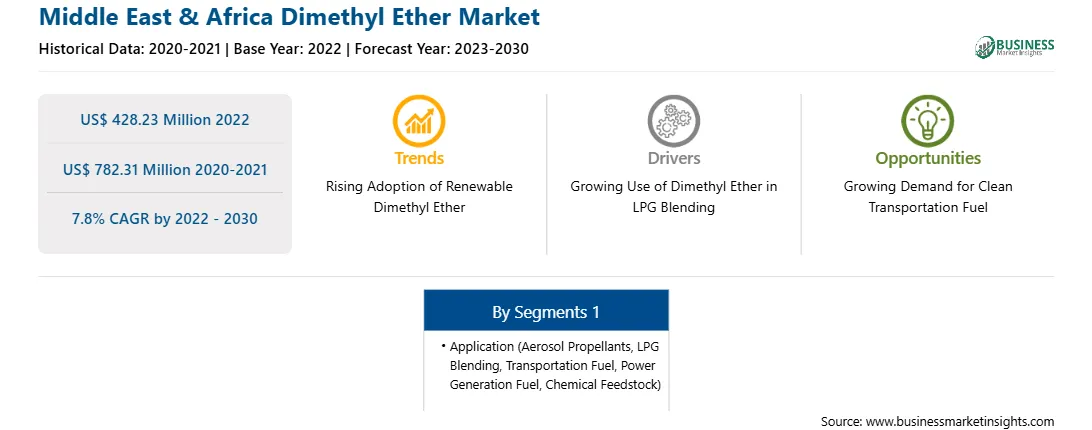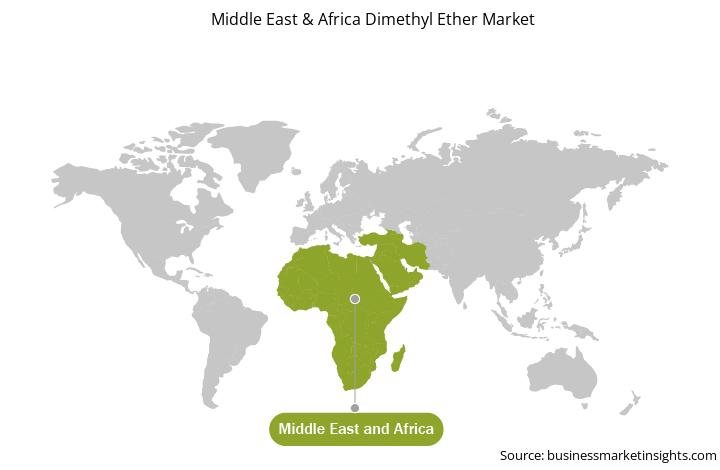The rising adoption of renewable dimethyl ether (rDME) is positively influencing the growth of the Middle East & Africa dimethyl ether market. As global concerns regarding climate change and environmental sustainability increase, industries and consumers seek cleaner and more sustainable energy sources. Renewable dimethyl ether, produced from renewable sources and waste feedstocks, aligns well with these aspirations and offers a compelling solution to reduce greenhouse gas emissions and dependence on fossil fuels. Renewable dimethyl ether has significant potential for lowering carbon emissions than conventional fossil fuels. rDME is produced from feedstocks such as biomass, agricultural residues, and waste materials, which are considered carbon-neutral or have a lower carbon footprint. Unlike traditional DME derived from fossil fuels, rDME cannot contribute to the net increase of carbon dioxide in the atmosphere when consumed as fuel. The transportation sector is a notable beneficiary of the rising adoption of rDME. Diesel engines can use rDME as a drop-in replacement for diesel fuel, requiring no modifications to existing infrastructure or engines. This ease of integration and the potential for immediate emission reductions make rDME an attractive option for reducing the carbon footprint of heavy-duty vehicles, trucks, and buses. Countries with ambitious emission reduction targets are particularly motivated to adopt rDME to achieve their sustainability goals.
rDME combustion generates fewer pollutants and particulate matter than conventional diesel, improving air quality in urban areas. As cities strive to combat air pollution and enhance public health, rDME is a valuable alternative fuel. The global push for energy security and reduced reliance on fossil fuels also drives the adoption of rDME. As rDME can be produced locally from diverse feedstocks, it offers a degree of energy independence and resilience against supply disruption that can occur with traditional fuels subject to geopolitical factors. Government strategies to promote renewable energy and reduce emissions further accelerate the adoption of rDME. Financial incentives, grants, and mandates for incorporating renewable fuels into transportation fleets encourage industries to invest in rDME production and utilization. In addition, manufacturers are also incorporating different strategies with the rising adoption of renewable dimethyl ether. Thus, all the aforementioned factors are expected to drive the Middle East & Africa dimethyl ether market growth during the forecast period.
Several economies in the Middle East & Africa are reducing dependence on fossil fuels by diversifying their energy sources. As per the International Trade Administration, in 2022, Saudi Arabia planned to expand the capacity of its power sector (electricity generation, transmission, distribution, and smart grid) due to rising demand from residential and commercial consumers. Developed economies in the Middle East & Africa, namely Saudi Arabia aimed to replace fossil fuel used to produce 42% of the country’s 110-gigawatt daily electricity needs in 2022, with a combination of 50% natural gas and 50% renewable energy by 2030. The government focus of replacement of traditional fuel sources with alternative sources can offer potential opportunities in the DME market. The Saudi Arabian Ministry of Energy’s spending on power and renewable energy projects is anticipated to reach US$ 293 billion by 2030. In 2021, the government of Saudi Arabia announced the country’s plan to spend US$ 38 billion on energy distribution by 2030. Due to ease of storage, transportation, and clean combustion characteristics, DME is a viable option for power generation in remote or off-grid locations. The utilization of emerging coal technologies, such as DME production, is gaining popularity in South Africa for utilization as alternative fuel. Therefore, rising renewable source-fueled power generation in the region is expected to boost the demand for DME.
The Middle East & Africa dimethyl ether market is segmented based on application and country.
Based on application, the Middle East & Africa dimethyl ether market is segmented into aerosol propellants, LPG blending, transportation fuel, power generation fuel, chemical feedstock, and others. The LPG blending segment held the largest market share in 2022.
Based on country, the Middle East & Africa dimethyl ether market is segmented into Saudi Arabia, South Africa, the UAE, and the Rest of Middle East & Africa. The Rest of Middle East & Africa dominated the Middle East & Africa dimethyl ether market share in 2022.
Nouryon Chemicals Holding BV, Shell Plc, Mitsubishi Gas Chemical Co Inc, The Chemours Co, Grillo-Werke AG, and Merck KGaA are some of the leading players operating in the Middle East & Africa dimethyl ether market.
Strategic insights for the Middle East & Africa Dimethyl Ether provides data-driven analysis of the industry landscape, including current trends, key players, and regional nuances. These insights offer actionable recommendations, enabling readers to differentiate themselves from competitors by identifying untapped segments or developing unique value propositions. Leveraging data analytics, these insights help industry players anticipate the market shifts, whether investors, manufacturers, or other stakeholders. A future-oriented perspective is essential, helping stakeholders anticipate market shifts and position themselves for long-term success in this dynamic region. Ultimately, effective strategic insights empower readers to make informed decisions that drive profitability and achieve their business objectives within the market.

| Report Attribute | Details |
|---|---|
| Market size in 2022 | US$ 428.23 Million |
| Market Size by 2030 | US$ 782.31 Million |
| Global CAGR (2022 - 2030) | 7.8% |
| Historical Data | 2020-2021 |
| Forecast period | 2023-2030 |
| Segments Covered |
By Application
|
| Regions and Countries Covered | Middle East and Africa
|
| Market leaders and key company profiles |
The geographic scope of the Middle East & Africa Dimethyl Ether refers to the specific areas in which a business operates and competes. Understanding local distinctions, such as diverse consumer preferences (e.g., demand for specific plug types or battery backup durations), varying economic conditions, and regulatory environments, is crucial for tailoring strategies to specific markets. Businesses can expand their reach by identifying underserved areas or adapting their offerings to meet local demands. A clear market focus allows for more effective resource allocation, targeted marketing campaigns, and better positioning against local competitors, ultimately driving growth in those targeted areas.

The Middle East & Africa Dimethyl Ether Market is valued at US$ 428.23 Million in 2022, it is projected to reach US$ 782.31 Million by 2030.
As per our report Middle East & Africa Dimethyl Ether Market, the market size is valued at US$ 428.23 Million in 2022, projecting it to reach US$ 782.31 Million by 2030. This translates to a CAGR of approximately 7.8% during the forecast period.
The Middle East & Africa Dimethyl Ether Market report typically cover these key segments-
The historic period, base year, and forecast period can vary slightly depending on the specific market research report. However, for the Middle East & Africa Dimethyl Ether Market report:
The Middle East & Africa Dimethyl Ether Market is populated by several key players, each contributing to its growth and innovation. Some of the major players include:
The Middle East & Africa Dimethyl Ether Market report is valuable for diverse stakeholders, including:
Essentially, anyone involved in or considering involvement in the Middle East & Africa Dimethyl Ether Market value chain can benefit from the information contained in a comprehensive market report.